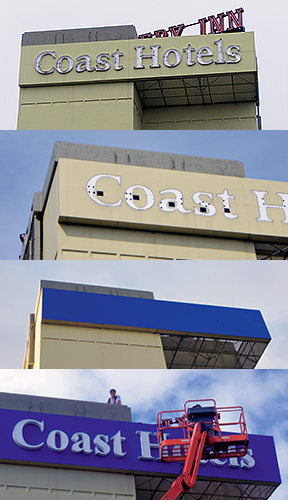
Depending on the situation, channel letters may need to be removed and retrofitted in the shop before reinstalling them in the field.
AHJs and retrofits
While the use of certified electrical products is mandatory in all provinces and territories, the ‘authority having jurisdiction’ (AHJ) will, in certain cases, impose additional requirements to ensure product certification is maintained within its area.
The use of a certified retrofit kit for signs— if it is approved for the type of sign and application in which it is to be installed and if it is installed as per the manufacturer’s instructions and in accordance with provincial or territorial legislation—would be acceptable for most AHJs ‘as is.’ Some AHJs, however, mandate an additional special inspection (SI), which must be performed before the installation can be accepted.
An SI is an assessment of electrical products in the field to determine their suitability for a given installation. It is performed as per CSA’s SPE-1000, Model Code for the Field Evaluation of Electrical Equipment.
Predominantly, an SI is used to allow equipment that is not certified or does not have a certification program to be accepted. Inspection bodies for this purpose must be accredited by SCC to be recognized by the provincial or territorial jurisdiction. (A list of all accredited inspection bodies can be found on SCC’s website, www.scc.ca.)
In cases where signs are being upgraded or modified without the use of an approved retrofit kit, AHJs are diligent in inspecting the installations, as they are well-aware of this practice. For the most part, these installations are rejected due to their use of uncertified components, but an SI is the only avenue by which they may potentially be accepted. The acceptance of an SI is and has always been at the discretion of the relevant AHJ.
Code references to AHJs
In Canada, every province and territory has adopted and continues to enforce the same installation code—CSA C22.1, Canadian Electrical Code (CEC)—although some do so with amendments. Regulatory authorities have been extremely active in the development of CEC over the years.
Section 34 of CEC covers the requirements for the installation of signs and outline lighting. While this section primarily provides direction for new installations, it should also be referenced for the installation of retrofit kits, as the certification of these kits is contingent upon the installation meeting both the manufacturer’s instructions and the requirements of CEC.
Specific requirements in Section 34 include the locations of signs and outline lighting, disconnecting means and supporting means. Additional rules are in place to cover thermal and overcurrent protection, grounding and bonding, enclosures, neon supplies and wiring methods.
Generally, the administration and adoption of CEC has been addressed at the provincial and territorial level, whereas the enforcement of CEC may be addressed at the provincial and/or municipal level. So, further information about CEC and specific requirements for the installation of retrofit kits in each jurisdiction can be obtained by contacting the appropriate provincial or territorial authority, which UL lists online.
With advances in lighting technology continuing to provide more energy-efficient LEDs and related products, it has become more difficult to navigate both regulatory requirements and product certifications in Canada. Fortunately, in response to such concerns, UL and other organizations are collecting the appropriate information online and offering assistance, interpretation and regulatory details.
Pierre McDonald is an Edmonton-based senior regulatory representative for Underwriters Laboratories Canada (ULC). For more information, contact him via e-mail at pierre.mcconald@ul.com.





